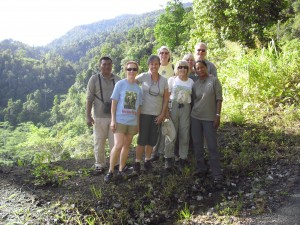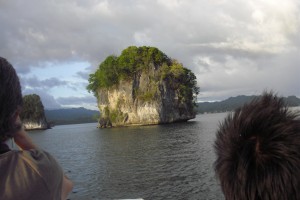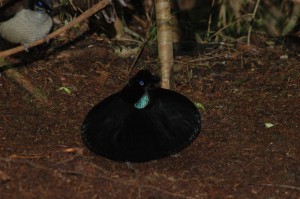Triumph and Tragedy in West Papua

Pat & Neal Rudikoff, Bruce & Barbara Bailey, Holly Miller, Suzanne Cordrey, Shita Prativi, Untu and Bonnie Zimmermann
We just returned from our 2009 Eco-Expedition in West Papua where we visited the island communites in the Raja Ampat Archipelago as well as the most northern tip of Papua outside of Manokwari at Arfak Mountain.
We would like to share a moment of triumph and a moment of tragedy from this trip. Even in the most remote reaches of Papua, civilization (and I’m not sure civilization is a good word) is rearing its ugly head and threatening parrot and exotic bird populations.
Although the main focus of IPP has always been curtailing the illegal trade in psittacines and working at the grassroots level to protect and conserve them - this is something bigger than all of us … and smaller.
The triumph …. Raja Ampat — we all pile into a boat and head out into nowhere , thousands of small stone islands, empty coastline, heavy seas and the feeling of being at the very end of the planet. Two hours later we reach our “stone island” roosting site for the Great Billed Parrot. We sit in the boat — the island is very tiny just a bump in the ocean. We wait some more, a few fruit doves, some raptors, and it starts getting dark. The guests are getting fidgety … the sun is going down, the light is amazing and there is a rainbow … then we hear the sounds… unmistakable … Great Billed Parrots screaming their heads off.

Roosting site for the Great Billed Parrot
Then they come … first maybe only twenty or so and we’re thrilled .. then just as we are about to lose the light … hundreds. We are sitting on the roof of the boat, amazed and astonished as hundreds of these birds swarm and flock and swoop above us. It is truly nature at it’s most perfect and remote. Finally it becomes too dark to see anymore, the birds have set to roost and we head back in the dark of night. This was inspiring and transformative.
Flash forward a few more days and we headed to see the Arfak Mountain 6-wired Bird of Paradise. The hike is grueling and dangerous - only about half the team decide to make the climb.
As we complete the 2+ hour straight up climb we head towards the blind to see this amazing Bird of Paradise. The blind is empty and the guides are upset. This was the only adult male in the area who regularly displayed for the females and was fondly called “the ballerina bird.”

Paradise Lost - Arfak 6-Wired Bird of Paradise - photo by Kris Tindige
Peril … several days prior one of the men from an adjoining village who was jealous that this village was getting rewarded for showing the bird (to National Geo, BBC, etc.) hiked up to the blind, caught the bird, killed it and ate it.
He ate it. In this area there are no other adult males and three or four juveniles that have four or five years before they mature. And who will teach them? In one moment of jealousy one man has impacted an entire eco-system.
Whether it is impact by man, technology, or the planet itself, we live in a very fragile world. So let’s respect and protect what we have — and remember no matter what, that every night … in the middle of nowhere there are parrots, cockatoos and exotic birds that still live free and wild.

















